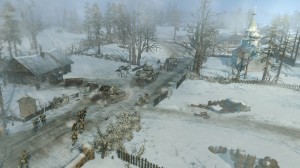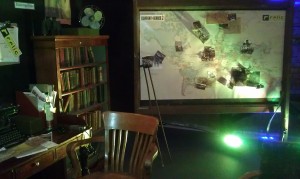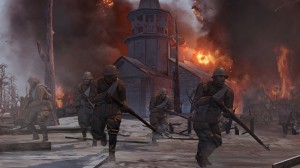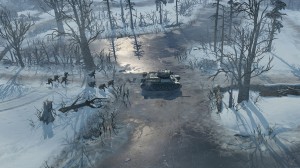Company of Heroes 2 Interview
- Updated: 18th Jul, 2012
 Company of Heroes was known for being infinitely replayable. Its emphasis on securing supply lines and reinforcing troops meant that hardcore RTS players could play the same map dozens, or even hundreds of times, and always have a different experience.
Company of Heroes was known for being infinitely replayable. Its emphasis on securing supply lines and reinforcing troops meant that hardcore RTS players could play the same map dozens, or even hundreds of times, and always have a different experience.
Moving east from from the original game’s French setting to the snowy landscapes of Russia, Company of Heroes 2 is set on the Eastern Front. The campaign sees you commanding Soviet troops from 1941’s German invasion, Operation Barbarossa, to the Battle in Berlin.
Relic Entertainment have built an enhanced version of their “Essence Engine 3.0” to give Company of Heroes 2 much more detail, while preserving the sense of freedom and wartime authenticity. Improvements have been made to line-of-sight with the “True Sight” feature, meaning that your troops’ vision will be obscured by trees and buildings. The snowy terrain will also affect movements, with infantry picking their way through deep snow and tanks slipping across icy roads.
 I spoke with General Manager Alex Peters and Studio Marketing Manager James McDermott about the setting, resource management and marketing a Soviet World War II setting across Germany.
I spoke with General Manager Alex Peters and Studio Marketing Manager James McDermott about the setting, resource management and marketing a Soviet World War II setting across Germany.
Being sensitive to the war – tell me more about how that comes across
Relic: The story is told through they eyes of a war correspondent. He’s working for the communist regime but as he goes through this… he’s Russian. He’s passionate for his nation but he starts to see the war from very different side.
He sees first-hand the brutality, the sacrifice that they have to give. They have to take lives to win wars but he also sees it on his own side with things like order 227 [No commander could allow their troops to retreat without orders from Front command] and the fact that Russian army was willing to kill their own for the better good of the cause.
What he wrestles with and what you’ll feel as you play the game – sometimes there’s no easy decision. There’s always choices and compromises and that fits through the whole narrative. You’ll feel that through little decisions you made; whether you decide to throw men into a situation where you know they’re going to get pinned. You’ll feel a connection, using them as cannon fodder to make your move.
How does doing such a historical game affect, say, the German market and the French market – people who would have been very involved.
Relic: We’re extremely respectful of tonality and not misrepresenting things. The German market has its own sensitivities and we’re very aware of that. Nazi ideology is not something you can ever promote in any way, shape or form in that market.
It’s not that they don’t acknowledge it. They do, they just don’t want to give that ideology a vehicle to manifest itself in modern form. We’re really sensitive to that. None of that exists in the game. We represent the German army as the Third Reich and the Iron Cross and more those kinds of terms rather than get too into the darker side of the ideology. More on the military and the battles and less about the “other” things that happens.
Relic: Yeah. It’s not like “don’t talk about it” but it’s not the focus of the game.
Do you go to the level of [historical] names and faces?
Relic: All of our names are fictitious characters that we’ve invented for the purpose of the game. We do take inspiration from generals and characters that fought in the war. Our protagonist is based loosely on a couple of books, which we can’t name as we’re working on the licencing.
It’s about representing a part of the war that so many people don’t know. The numbers involved – people aren’t aware of what happened in Russia. To go to that theatre of war is great for us. We feel it’s fair and representing more parts of the war. We only covered the end of the war with the first game.
In modern media no one really explores the Russian conflict fully. We have movies like Enemy At The Gates but it doesn’t really give you the full context of what happened and why it’s so significant. Everyone knows the beach at Normandy but nobody really knows truly what happened in these other battles at Stalingrad. It’s exciting to be able to bring that forward and educate people as well.
Is there any meta game. If you lose this mission over here does that have an impact over there?
Relic: Not in the single player campaign. It’s an interesting idea and it may appear somewhere else but we can’t really confirm right now. In the single player decision-making, everything within the context of a single battle can be played out multiple different ways. With the original, people will play the same map 150 times because every time they play, it’s a different outcome based on the tactical decisions they made. We definitely want to bring that part of the gameplay through.
 We have single player and multiplayer. We’ll have numerous modes within those but we’re not confirmed yet.
We have single player and multiplayer. We’ll have numerous modes within those but we’re not confirmed yet.
Can you burn through the deep snow with the flamethrower?
Relic: The environment is deformable. Artillery, cannons can destroy it. An area with deep snow, you could bombard that. You can make it an easier walking path if you wanted to do that. The flamethrower is very useful for burning down buildings. The enemies will scatter out, buildings can burn down to the ground. you could have effectively a village on fire. You can also use it break up troops. In their cover position if you use the flamethrower they’ll scatter out.
How does resource management work?
Relic: You start with squads and troops as you progress further there’s more base building. You’ll build your primary base and you’ll be taking objectives. It’s not a game about building huge armies. It’s about having a strategy and building squads that you can utilise to solve problems on the battlefield. You wont have little mines that give you coal and stuff. We focus more on action.
Thanks very much for the interview
Find out more on the official Company of Heroes 2 website.


Follow Us!